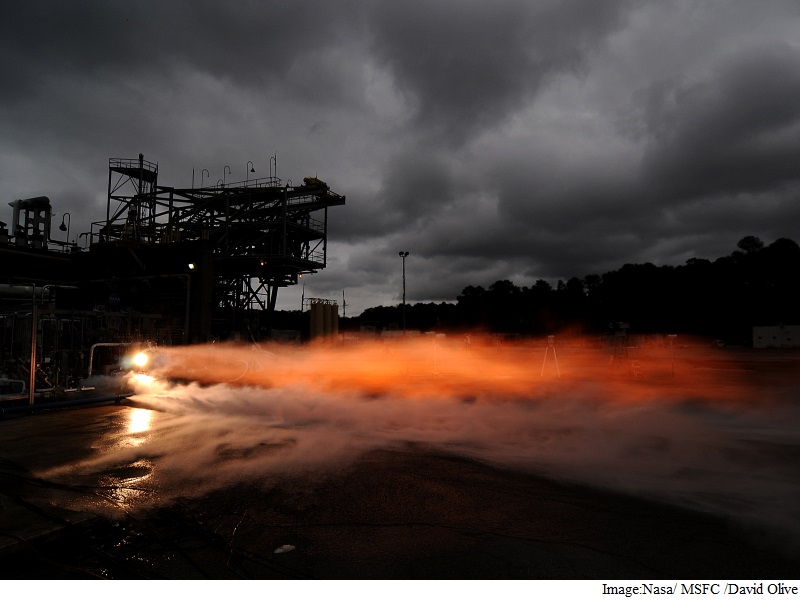- Home
- Science
- Science News
- 3D Printed Rocket Engines to Propel Nasa Missions Soon
3D-Printed Rocket Engines to Propel Nasa Missions Soon

The team from Nasa's Marshall Space Flight Centre in Huntsville, Alabama tested 3D printed rocket engine parts connected together in the same fashion that they would work in a rocket engine.
The parts performance rivalled that of traditionally manufactured engine parts. During six separate tests, the engine generated up to 20,000 pounds of thrust.
"We manufactured and then tested about 75 percent of the parts needed to build a 3D printed rocket engine," said Elizabeth Robertson, project manager at Nasa.
"By testing the turbo pumps, injectors and valves together, we've shown that it would be possible to build a 3D printed engine for multiple purposes such as landers, in-space propulsion or rocket engine upper stages," Robertson explained in a statement.
Over the last three years, the Marshall team has been working with various vendors to make 3D printed parts, such as turbo pumps and injectors, and test them individually.
To test them together, they connected the parts so that they work the same as they do in a real engine.
"In engineering language, this is called a breadboard engine," explained Nick Case, testing lead for the effort.
Seven tests were performed with the longest tests lasting 10 seconds.
During the tests, the 3D printed demonstrator engine experienced all the extreme environments inside a flight rocket engine where fuel is burned at greater than 3,315 degrees Celsius to produce thrust.
"These Nasa tests drive down the costs and risks associated with using additive manufacturing, which is a relatively new process for making aerospace quality parts," Robertson noted.
"This new manufacturing process has opened the design space and allowed for part geometries that would be impossible with traditional machining or casting methods," added David Eddleman, one of Marshall's propulsion designers.
Additive manufacturing or 3D printing is a key technology for enhancing space vehicle designs and manufacturing and enabling more affordable exploration missions.
For the latest tech news and reviews, follow Gadgets 360 on X, Facebook, WhatsApp, Threads and Google News. For the latest videos on gadgets and tech, subscribe to our YouTube channel. If you want to know everything about top influencers, follow our in-house Who'sThat360 on Instagram and YouTube.
Related Stories
- Samsung Galaxy Unpacked 2025
- ChatGPT
- Redmi Note 14 Pro+
- iPhone 16
- Apple Vision Pro
- Oneplus 12
- OnePlus Nord CE 3 Lite 5G
- iPhone 13
- Xiaomi 14 Pro
- Oppo Find N3
- Tecno Spark Go (2023)
- Realme V30
- Best Phones Under 25000
- Samsung Galaxy S24 Series
- Cryptocurrency
- iQoo 12
- Samsung Galaxy S24 Ultra
- Giottus
- Samsung Galaxy Z Flip 5
- Apple 'Scary Fast'
- Housefull 5
- GoPro Hero 12 Black Review
- Invincible Season 2
- JioGlass
- HD Ready TV
- Laptop Under 50000
- Smartwatch Under 10000
- Latest Mobile Phones
- Compare Phones
- Moto G15 Power
- Moto G15
- Realme 14x 5G
- Poco M7 Pro 5G
- Poco C75 5G
- Vivo Y300 (China)
- HMD Arc
- Lava Blaze Duo 5G
- Asus Zenbook S 14
- MacBook Pro 16-inch (M4 Max, 2024)
- Honor Pad V9
- Tecno Megapad 11
- Redmi Watch 5
- Huawei Watch Ultimate Design
- Sony 65 Inches Ultra HD (4K) LED Smart TV (KD-65X74L)
- TCL 55 Inches Ultra HD (4K) LED Smart TV (55C61B)
- Sony PlayStation 5 Pro
- Sony PlayStation 5 Slim Digital Edition
- Blue Star 1.5 Ton 3 Star Inverter Split AC (IC318DNUHC)
- Blue Star 1.5 Ton 3 Star Inverter Split AC (IA318VKU)

















